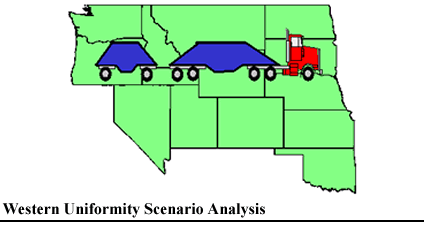
In 2000 the U. S. Department of Transportation (DOT) issued the Comprehensive Truck Size and Weight (CTS&W) Study, the first such study by DOT since 1981. The CTS&W Study analyzed five truck size and weight scenarios varying from a rollback of size and weight limits to nationwide operations of longer combination vehicles (LCVs). These scenarios were intended only to illustrate the capabilities of the analytical tools. They were not intended to reflect policy options that might be implemented.
The Western Governors' Association (WGA) requested that DOT analyze an additional scenario that would be limited to Western States already allowing LCVs. Specifically the WGA asked the Department to analyze a policy option that would allow 13 Western States (see Figure II-1) to harmonize LCV weights and dimensions at levels that meet existing federal axle load limits, the Federal Bridge Formula and that are in accordance with guidelines established by the Western Association of State Highway and Transportation Officials (WASHTO). Due to time constraints, the scenario could not be included in the CTS&W Study Volume III, but the Department agreed to analyze the scenario in a follow-up report.
This analysis draws heavily on work done for the CTS&W Study. General background information on the evolution of truck size and weight limits and previous research on potential impacts of truck size and weight policy changes was included in the CTS&W Study Volumes I - IV and is not repeated in this report. This report does discuss the many data and analytical improvements since the CTS&W Study and included in the Western Uniformity Analysis. This report is not intended as a “stand-alone” report, important background and methodology information is included in Volumes I - IV of the CTS&W Study.
The purpose of this analysis is to use the general analytical framework developed in the CTS&W Study to analyze impacts of the Western Uniformity Scenario that the WGA asked DOT to analyze. As with scenarios analyzed in the CTS&W Study, there is no detailed discussion of regulatory, enforcement, or other implementation issues that would have to be considered before an option such as the Western Uniformity Scenario could be implemented.
The impacts of the Western Uniformity Scenario are estimated for 10 impact areas:
Additional information on each of these impacts can be found in the CTS&W Study Volumes II and III.
The Western Uniformity Scenario analysis includes several substantial improvements to data and methods used in the CTS&W Study to estimate scenario impacts. Improvements in the truck and rail data and methods used to analyze pavement, bridge, and safety impacts are discussed in the relevant sections of the report.
One of the biggest improvements is the use of the Freight Analysis Framework (FAF) commodity flow data in place of the very limited truck flow data that was available at the time the CTS&W Study was undertaken. The FAF is a comprehensive database widely used by the Federal Highway Administration (FHWA) for a variety of freight operations analyses. It includes estimates of county-to-county flows of all manufacturing and agricultural truck shipments. Also the!database for analyzing potential diversion of rail traffic to larger, heavier trucks has been updated to 2000. These new rail data reflect impacts of the 1990's rail mergers.
During the course of this study FHWA staff met on several occasions with representatives of State Departments of Transportation to understand current LCV operations, regulations and routes. Although all 13 States in the Scenario have assisted with the project, their participation does not necessarily reflect a State's policy direction toward implementation of the LCV sizes, weights and networks analyzed in this report.
FHWA staff met with LCV operators to understand characteristics of their operations. State officials and regional LCV operators were very helpful in providing a picture of current operations, configurations and the LCV shipping environment.
FHWA staff also met with safety groups to understand their concerns about truck operations and especially LCVs.
As with the CTS&W Study's scenario analysis, there is a broad assessment of potential impacts that might result from the changes in truck size and weight (TS&W) limits assumed in this scenario. Chapter II provides a detailed description of assumptions underlying the Western Uniformity Scenario. Chapter III describes methods used to estimate the shifts in truck traffic that could result from scenario assumptions. These shifts include those rail boxcar and intermodal freight to trucks and from existing truck configurations to larger and heavier configurations that would be allowed under the scenario. Finally Chapter III estimates the impact to shippers' freight bills.
Chapters IV through VI present estimates of scenario impacts on highway agency costs for pavement, bridge, and geometric improvements respectively. Chapters VII through IX estimate external costs (or benefits) that might result under scenario assumptions. The impacts covered in these chapters are safety, traffic operations, and energy consumption and environmental quality respectively. Chapters X estimates reductions in rail traffic and the impacts of the scenario on railroads serving the region. Chapter XI summarizes scenario impacts.